I'll assume that you're using tracing within your application and using opentelemetry and opentelemetry-jaeger to wire it up to an external service. The specific provider you're using doesn't matter. Here's a super simple setup to get that all working that I'll assume you're using on both applications:
# Cargo.toml
[dependencies]
opentelemetry = "0.17.0"
opentelemetry-jaeger = "0.16.0"
tracing = "0.1.33"
tracing-subscriber = { version = "0.3.11", features = ["env-filter"] }
tracing-opentelemetry = "0.17.2"
reqwest = "0.11.11"
tokio = { version = "1.21.1", features = ["macros", "rt", "rt-multi-thread"] }
warp = "0.3.2"
opentelemetry::global::set_text_map_propagator(opentelemetry_jaeger::Propagator::new());
tracing_subscriber::registry()
.with(tracing_opentelemetry::layer().with_tracer(
opentelemetry_jaeger::new_pipeline()
.with_service_name("client") // or "server"
.install_simple()
.unwrap())
).init();
Let's say the "client" application is set up like so:
#[tracing::instrument]
async fn call_hello() {
let client = reqwest::Client::default();
let _resp = client
.get("http://127.0.0.1:3030/hello")
.send()
.await
.unwrap()
.text()
.await
.unwrap();
}
#[tokio::main]
async fn main() {
// ... initialization above ...
call_hello().await;
}
The traces produced by the client are a bit chatty because of other crates but fairly simple, and does not include the server-side:

Let's say the "server" application is set up like so:
#[tracing::instrument]
fn hello_handler() -> &'static str {
tracing::info!("got hello message");
"hello world"
}
#[tokio::main]
async fn main() {
// ... initialization above ...
let routes = warp::path("hello")
.map(hello_handler);
warp::serve(routes).run(([127, 0, 0, 1], 3030)).await;
}
Likewise, the traces produced by the server are pretty bare-bones:

The key part to marrying these two traces is to declare the client-side trace as the parent of the server-side trace. This can be done over HTTP requests with the traceparent and tracestate headers as designed by the W3C Trace Context Standard. There is a TraceContextPropagator available from the opentelemetry crate that can be used to "extract" and "inject" these values (though as you'll see, its not very easy to work with since it only works on HashMap<String, String>s).
For the "client" to send these headers, you'll need to:
- get the current tracing
Span
- get the opentelemetry
Context from the Span (if you're not using tracing at all, you can skip the first step and use Context::current() directly)
- create the propagator and fields to propagate into and "inject" then from the
Context
- use those fields as headers for reqwest
#[tracing::instrument]
async fn call_hello() {
let span = tracing::Span::current();
let context = span.context();
let propagator = TraceContextPropagator::new();
let mut fields = HashMap::new();
propagator.inject_context(&context, &mut fields);
let headers = fields
.into_iter()
.map(|(k, v)| {(
HeaderName::try_from(k).unwrap(),
HeaderValue::try_from(v).unwrap(),
)})
.collect();
let client = reqwest::Client::default();
let _resp = client
.get("http://127.0.0.1:3030/hello")
.headers(headers)
.send()
.await
.unwrap()
.text()
.await
.unwrap();
}
For the "server" to make use of those headers, you'll need to:
- pull them out from the request and store them in a
HashMap
- use the propagator to "extract" the values into a
Context
- set that
Context as the parent of the current tracing Span (if you didn't use tracing, you could .attach() it instead)
#[tracing::instrument]
fn hello_handler(traceparent: Option<String>, tracestate: Option<String>) -> &'static str {
let fields: HashMap<_, _> = [
dbg!(traceparent).map(|value| ("traceparent".to_owned(), value)),
dbg!(tracestate).map(|value| ("tracestate".to_owned(), value)),
]
.into_iter()
.flatten()
.collect();
let propagator = TraceContextPropagator::new();
let context = propagator.extract(&fields);
let span = tracing::Span::current();
span.set_parent(context);
tracing::info!("got hello message");
"hello world"
}
#[tokio::main]
async fn main() {
// ... initialization above ...
let routes = warp::path("hello")
.and(warp::header::optional("traceparent"))
.and(warp::header::optional("tracestate"))
.map(hello_handler);
warp::serve(routes).run(([127, 0, 0, 1], 3030)).await;
}
With all that, hopefully your traces have now been associated with one another!

Full code is available here and here.
Please, someone let me know if there is a better way! It seems ridiculous to me that there isn't better integration available. Sure some of this could maybe be a bit simpler and/or wrapped up in some nice middleware for your favorite client and server of choice... But I haven't found a crate or snippet of that anywhere!


